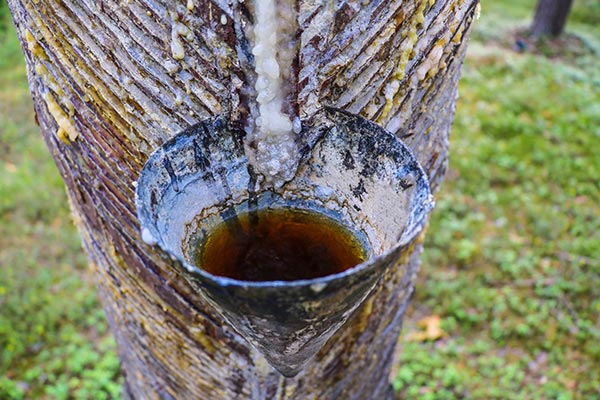
Advertisement
Pine sap is the sticky substance secreted by pine trees. It has a consistency that is similar to honey or syrup. Pine trees produce this sap when they are injured, such as when tree limbs or branches break off or when insects or other animals create openings in the tree’s bark. The pine sap then hardens and creates a protective layer over the injury to seal it and help it heal. When SHTF, this highly versatile natural resource can be of great use and value to you. Follow this guide to learn how to use pine sap during survival situations. (h/t to UrbanSurvivalSite.com)
Once pine sap has been exposed to the air, it begins to harden and crystallize into pitch until it eventually forms a dark amber glob called resin. The great thing about resin is that it can still be softened into its original sap-like form by warming it over the fire. This means that you don’t need to injure a pine tree to harvest pine sap, unless necessary. If you’re lucky, you can simply find some hardened resin and use a survival knife to physically remove it. You can then melt down this lump of resin using heat to make it runny and viscous again.
Use pine sap for first aid
If pine sap is what trees use to seal off wounds and prevent infections, then who says you can’t use it to bandage your own wounds? Not only does pine sap possess antibacterial, antiseptic, astringent and anti-inflammatory properties, but it is also sticky enough to help slow down or even stop the flow of blood.
Before applying the sap to the wound, be sure to clean your wound thoroughly. Pine sap is also edible, but don’t eat it straight off the tree. Always boil pine sap first to remove bacteria and impurities, as well as make it viscous and easy to ingest. In the colonial days, pine was often used as a natural remedy for treating ulcers, excessive coughing and breathing problems. If you’re suffering from a sore throat or a cold out in the woods, then you can chew on some pine sap to alleviate the symptoms.
Use pine sap to start a fire
Pine sap is highly flammable, meaning it can serve as makeshift tinder if you need to start a fire. Simply pour some pine sap over your kindling before igniting it with a spark. You can also use a small dime-sized piece of resin as a fire extender. If you need to create a makeshift torch, wrap the top of a stick with a piece of cloth and cover it with pine sap. You can also use pitch sticks to make DIY survival candles. (Related: How to use sticky pine sap to survive in the wild: treating rashes, starting fires and more.)
Use pine sap to repair items
Because pine sap is so sticky, it is basically a natural form of glue. You can use it to patch up holes in tents and tarps or repair clothing and other items. Pine sap is great for hafting arrowheads, fletching arrows and gluing other primitive tools and weapons together. Instead of bringing glue along with you when bugging out, you can carry hardened resin crystals with you in a small pouch. Whenever you are in need of makeshift repairs, simply take out a few resin crystals and soften them up over a fire.
Use pine sap to protect your belongings from water damage
Pine sap can be used to make items resistant to water, such as your clothes and your backpack. Keep water out of your shoes and boots by sealing them with resin.
Like many natural resources, pine sap can come in handy if you know how to use it in a survival situation. Learn other survival uses for pine sap by visiting Survival.news.
Sources include:
Advertisement
Advertisements
















